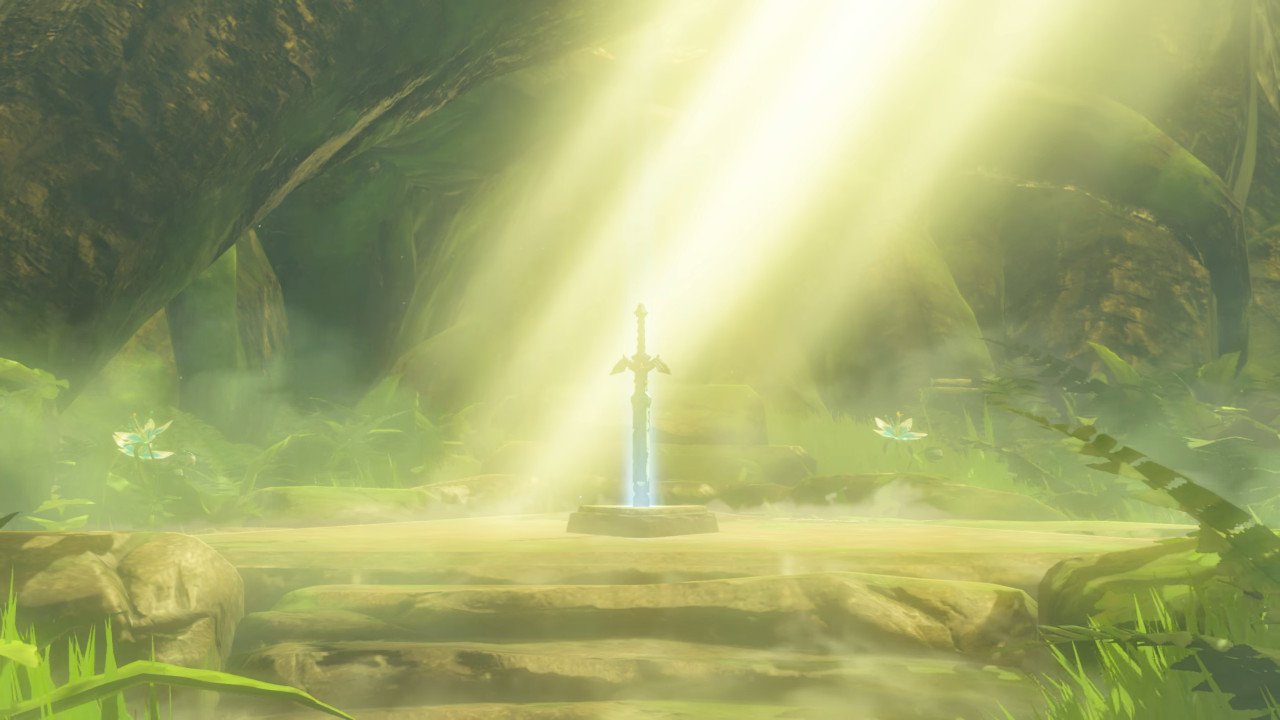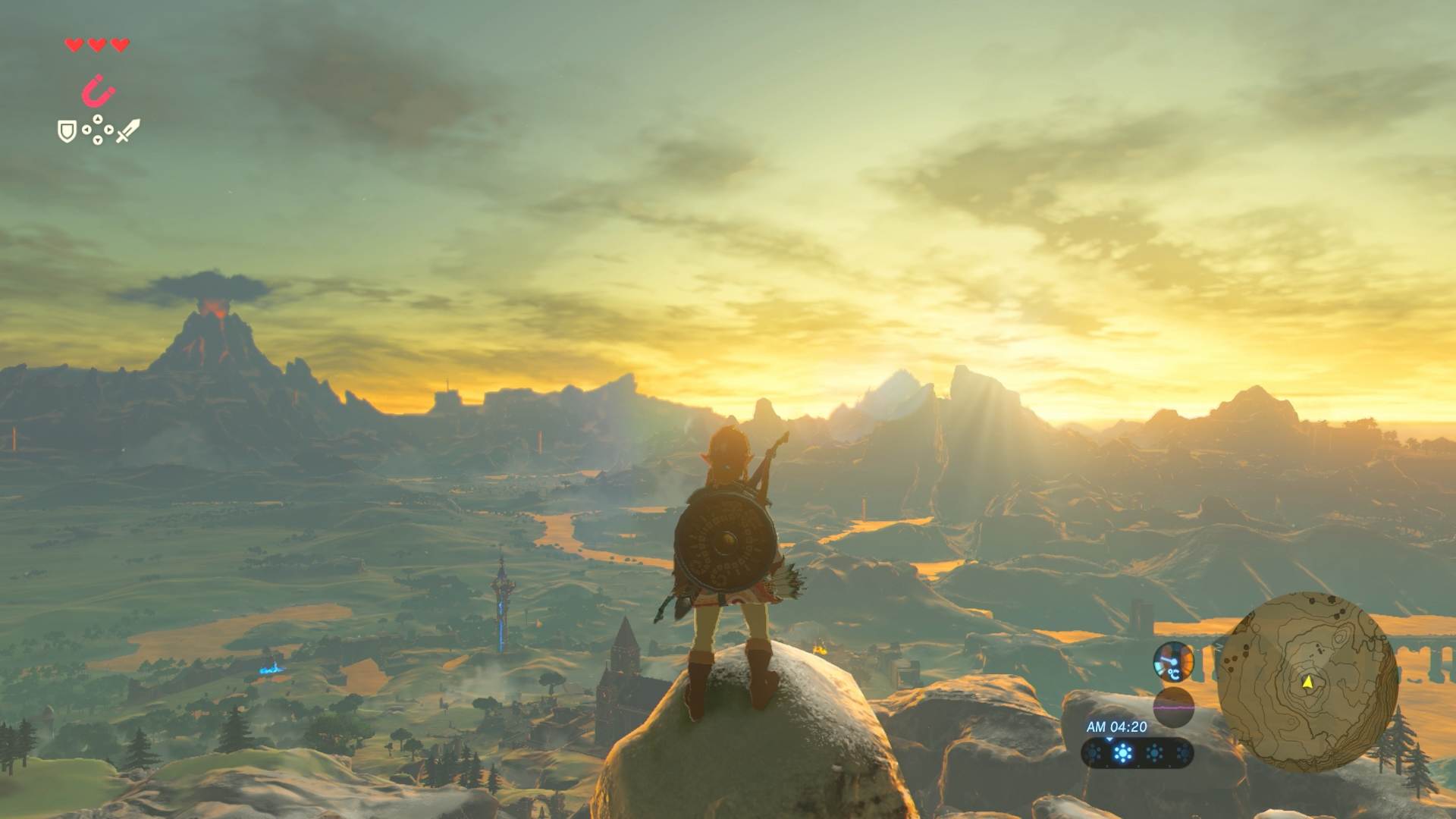In Part 1 of this series, I talked about my overall impressions of the Switch and it’s place in the spectrum of “home console” versus “handheld” gaming system. Part 2 covered some more detail about the ingenius Joy Con controllers as well as the Pro Controller, and the different modes of play that the system supports. Part 3 covered the software end of things, including the system software, Snipperclips, and 1-2-Switch. This post will focus on The Legend of Zelda: Breath of the Wild.
Greatness In the Air
From the first moments of Breath of the Wild, one thing is abundantly clear: this is a Great game. Great with a capital G. It’s clearly the result of dozens of incredibly talented artists working at the peak of their abilities. Every aspect of the game seems like it has been thoughtfully considered and fussed over. The sheer joy in playing it feels sort of similar to the way it felt to run around the castle courtyard in Super Mario 64. It was an entirely new kind of game, and as a player you just wanted to breathe it in.

It is a beautifully rendered game. Nintendo have long been skeptical of the hardware rat race that other consoles have long been participating in, choosing as far back as the GameCube to intentionally use less powerful hardware that instead enabled interesting scenarios. As far as the Switch’s graphics processing horsepower is concerned, it’s very similar to the Wii U. It represents a tiny step forward, but of course it’s in a much smaller, portable form factor that also includes a touchscreen and a battery and whatnot. Which is to say that, while Breath of the Wild isn’t about to set any records for highest polygon count or 4K resolution textures, it is nevertheless an incredibly eye-pleasing game. The above image of the master sword is not a pre-rendered promotional still. It is not from a cutscene. It’s just a screenshot I took (using the Switch’s built-in screenshot functionality) during normal gameplay.
The Look
The game uses a cel-shading technique sort of like Wind Waker, but the body types and physicality of the characters is less cartoony. It’s a nice evolution of the style Nintendo has been refining over the last several games, and I like this path a lot better than if they had continued to fall into the “everything must be ‘darker’ and ‘grittier’ with each successive game” trap that it seemed like they were falling into with Twilight Princess and some of the early “Zelda HD” proof of concept videos.
The really amazing thing about the graphics is not the characters, it’s the environment. As the title implies, the real star of this game is “the wild.” Getting from Kakariko Villiage to Zora’s Domain is as much a “level” as any of the actual dungeons you must complete. This is driven home by the incredible draw distance of the environment.

Each time you venture to a new region of the overworld, you must navigate by climbing to high places (the Shiekah Towers scattered throughout the game) and surveying your whereabouts. You can literally see for dozens of miles when atop one of these towers. It’s an open-world game, so once you complete the small introductory segment at the beginning, there’s nothing stopping you from running off to the edge of the continent in any given direction, which could take hours.
The Feel
The game does a very good job of giving you landmarks to navigate by when atop one of these high towers, and you can pretty much pick any place you can see and go there. There are no convenient obstacles that block you from going to the next area until you retrieve the dungeon item from the one you’re currently in, as with most previous Zelda games. The only real thing to stop you from going to certain areas early in the game is the presence of enemies that are too strong for you to face when you have only a couple heart containers, but even those can generally just be avoided by choosing a different route.
Speaking of dungeon items, those are mostly gone. The small tutorial segment at the beginning of the game imbues Link with a few magical abilities that you must get before you can leave the introductory area. These consist of: two kinds of bombs, a magnet which can be used to pick up and manipulate metal objects, the ability to “stop time” on certain objects, and an ability to create platforms out of ice on top of water which you can then climb.
Upon getting all of those abilities, you also receive a paraglider, which you can use to descend the sheer cliffs of introductory area. That’s essentially it, there are no more major abilities that enable you to reach new areas, you can go anywhere in the game at that point.
A lot has been said about the ways this game breaks with many of the conventions that had previously defined the Zelda series: you must collect supplies and cook food to get hearts, you must constantly find new weapons and shields as they will break after a few uses, the master sword is entirely optional. However I think the biggest differentator is the shrines.
Shrine Get
Rather than the traditional series of dungeons that all follow the same pattern (sovle some puzzles, get the map, beat the miniboss, get the dungeon item, beat the boss), this game has a whole bunch of “shrines” strewn across it’s landscape. 120 of them to be exact. These are essentially micro-dungeons, many offer a single puzzle to be solved or enemy to be defeated.
The effect of this is twofold: it encourages exploration and keeps the focus on the game’s overworld since half the challenge is finding and entering the shrines, and it enables you to progress in any order you like. The shrines don’t have “dungeon items,” so there’s nothing stopping you from going to the furthest one from you and doing that before you do the one that is right next to your starting point.
The closest analogue to traditional Zelda dungeons are the four “Divine Beasts,” which are giant robotic creatures that were built to fight Ganon but who were overtaken by him. Even these aren’t really dungeons in the classic mode. There is a map for each, but there are no “dungeon items” and very few enemies (and no mini-bosses). Each is essentially one big room, and you must activate five “terminals” (accessed by rotating or re-arranging the level itself in clever ways), and then you fight one boss. They are relatively short, compared to any given dungeon in Link to the Past or Ocarina of Time or what-have-you.
Again, this is clearly done to keep the focus on the overworld. Did I mention that the overworld is massive? At 360 square kilometers, it’s overworld is 376 times bigger than Twilight Princess and 3,673 times bigger than Ocarina of Time. So, despite the fact that there are “only” four dungeons (not including the final Ganon confrontation), the game feels anything but small.
As of this writing, I have finished three of the four dungeons. However, it still feels like I have completed roughly 6% of the game. I’m not just counting collecting every random item and maxing out every possible upgrade, there’s so much content and story that is only uncovered if you explore everything and talk to everyone that I still feel like I’ve only begun to scratch the surface.
Flight of the Navigator
If I had one complaint about the game, it’s that Nintendo may have doubled-down a little too hard on the removal of clues as to what you should be doing at any given time in this game. Don’t get me wrong, I’m as happy as anyone that there’s no Navi or Fi or Clippy popping up constantly to yell at you, but I will say that I’ve also had to consult guides more frequently than any other Zelda game (aside from maybe the very first one), just to find out where the hell I’m supposed to be heading toward at any given time.
As great and vast and interesting as the overworld is, it can be difficult to see the forest for the trees at times, and while you can happily spend as much time as you want running around and collecting mushrooms and fighting minor enemies for loot, it can be a little frustrating when you feel like you actually want to make progress but feel like you’re just kind of blindly rushing toward the horizon and hoping that you’re heading the right direction.
A caveat with that complaint is that I will fully admit that I am terrible at having a sense of direction in 3D games. For whatever reason I often wind up getting turned around and going back the way I came when trying to navigate dungeons and such, and that’s in every 3D zelda game, not just this one. So your mileage may vary.
The only other complaint that I have is that it rains too frequently in the overworld. Climbing is such an integral function in this game, and is effectively the only way to reach many areas and traverse across Hyrule. However, when it rains you can’t climb because surfaces are too slippery. Which is a nice touch, and makes sense logically, but when you’re halfway up some giant precipice that takes fifteen minutes to climb and it starts raining, you’re resigned to either abandoning what you were doing or just kind of standing around for ten minutes waiting for the storm to pass, which isn’t exactly “fun.”
Replay Value
Paul Verhoeven (no relation) noted on the 28 Plays Later podcast that he thought the open-world nature of this game meant that it would not bear repeat plays in the same way as most of the more conventionally narrative driven Zelda games. As someone who tends to “run the series” on a fairly regular basis, that bummed me out a bit, and in the early going I totally agreed.
As I progress further into the game, however, I’m not so sure. Some of the problems with feeling aimless or lost in the vast world will obviously not be an issue on subsequent plays, and while I plan to complete as many of the side-quests and things as I feasibly can on this initial play through, you obviously don’t have to do those things if you just want to run through the major beats of the game.
One thing that the game does well is that it gives you some “nice to have” upgrades as you proceed through the Divine Beasts, one in particular eases travelling so much that I would definitely do that stage first on any future subsequent playthroughs. When just wandering around the world and investigating various things has lost some of it’s luster, I’m beginning to think that playing through the major beats will still be a pretty enjoyable way to revisit this game.
Parting Thought
As I mentioned above, as of this writing I’ve finished three of the four divine beasts, and I’m planning to do a bunch of the side content, which up to now I’ve largely ignored, before actually attempting the final boss (I’m still a bit of a completist, though I have no intention of collecting all 900 Korok seeds or whatever).
I will probably write another post from a retrospective vantage after finishing the game just to see if it meshes with my early feelings here.
It is a beautiful, challenging and joyful game that does a lot of very interesting things with the Zelda formula. Get a strategy guide, though.
